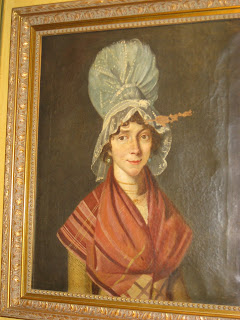Café Procope bar
Last month while in France for a month I got a chance to eat at one of my favorate restaurants in Paris about 4 times! On this visit I had my favorate dish Coq au vin. The Café Procope, in rue de l'Ancienne Comédie, 6th arrondissement, is called the oldest restaurant of Paris in continuous operation. It was opened in 1686 by the Sicilian chef Francesco Procopio dei Coltelli.
It's a joy to eat Coq au vin in a place full of history where Benjamin Franklin, then Ambassador to France, worked on the U.S. Constitution at a table.
The Café Procope, in the street then known as rue des Fossés-Saint-Germain-des-Prés, started as a café where gentlemen of fashion might drink coffee, the exotic beverage that had previously been served in taverns, or eat a sorbet, served up in porcelain cups by waiters in exotic "Armenian" garb.
Louis, chevalier de Mailly, in Les Entretiens des caffés, 1702, remarked:
The cafés are most agreeable places, and ones where one finds all sorts of people of different characters. There one sees fine young gentlemen, agreeably enjoying themselves; there one sees the savants who come to leave aside the laborious spirit of the study; there one sees others whose gravity and plumpness stand in for merit. Those, in a raised voice, often impose silence on the deftest wit, and rouse themselves to praise everything that is to be blamed, and blame everything that is worthy of praise. How entertaining for those of spirit to see originals setting themselves up as arbiters of good taste and deciding with an imperious tone what is over their depth!
Throughout the 18th century, the brasserie Procope was the meeting place of the intellectual establishment, and of the nouvellistes of the scandal-gossip trade, whose remarks at Procope were repeated in the police reports. Not all the Encyclopédistes drank forty cups of coffee a day like Voltaire, who mixed his with chocolate, but they all met at Procope, as did Benjamin Franklin, John Paul Jones and Thomas Jefferson.
Le Procope is in 18th-century style
Francesco Procopio
dei Coltelli – founder
Voltaire's desk
During the Revolution, the Phrygian cap, soon to be the symbol of Liberty, was first displayed at the Procope; the Cordeliers, Robespierre, Danton and Marat all used the cafe as a meeting place. After the Restoration, another famous customer was Alexander von Humboldt, who lunched here during the 1820s every day from 11am to noon. The Procope retained its literary cachet: Alfred de Musset, George Sand, Gustave Planche, the philosopher Pierre Leroux, M. Coquille, editor of Le Monde, Anatole France were all regulars. Under the Second Empire, August Jean-Marie Vermorel of Le Reforme or Léon Gambetta would expound their plans for social reform.
Legend has it that in 1795 Napoleon, who was serving in the French army during the Revolution, was forced to leave his hat as collateral to the restaurant’s owner to pay off his debts. The Procope’s hat is not the only one that has been worn by the emperor. A few have survived him until today. If you happen to possess one of Napoleon’s hats, your fortune is made. In 2014, one of them fetched no less than $2.57 million at a Paris auction.
Le Procope main entrance
Le Procope main entrance











































































